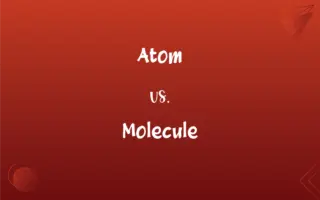Implosion vs. Explosion: What's the Difference?
Edited by Aimie Carlson || By Janet White || Published on September 22, 2024
An implosion is the inward collapse of a structure, while an explosion is a violent expansion with forceful ejection of material.

Key Differences
Implosion and explosion represent two fundamentally opposite processes. An implosion occurs when an object collapses inward due to external pressure exceeding internal pressure, causing the structure to fall or compress inwardly. This process is often controlled and used in demolition to bring down buildings without damaging nearby structures. Explosion, in contrast, involves a rapid increase in volume and release of energy in an extreme manner, typically accompanied by the generation of high temperatures and the release of gases. Explosions can be chemical, nuclear, or mechanical in nature and are characterized by the outward blast of debris and shockwaves.
Both phenomena involve a rapid release of energy, the direction in which that energy moves is what differentiates an implosion from an explosion. In an implosion, the energy is directed inward, leading to the collapse of the material. In an explosion, the energy is directed outward, leading to an expansion and often destruction in the surrounding area.
Implosions are often used in scenarios where space is limited and collateral damage must be minimized, such as in urban demolition. Explosions have a wide range of applications, from industrial uses like mining to military applications. Despite their destructive power, explosions are also harnessed for beneficial purposes, such as in life-saving airbag deployment in vehicles.
The physics behind implosions and explosions involve complex interactions of forces, pressures, and materials. Implosions require a vacuum or lower pressure inside an object compared to its surroundings, leading to collapse. Explosions result from a rapid increase in pressure inside an object until it exceeds the material's ability to contain it, causing the object to burst apart and release energy.
Comparison Chart
Direction of Force
Inward, towards the center.
Outward, away from the source.
ADVERTISEMENT
Application
Controlled demolition, submarines.
Mining, demolition, military, propulsion.
Energy Release
Energy is directed inward.
Energy is released outward.
Pressure Dynamics
External pressure exceeds internal pressure.
Internal pressure exceeds containment ability.
Typical Outcome
Collapse of structure.
Dispersal of material and shockwaves.
Implosion and Explosion Definitions
Implosion
The inward collapse under external pressure.
The submarine suffered an implosion due to the extreme ocean depth.
ADVERTISEMENT
Explosion
Release of energy from nuclear reactions.
A nuclear explosion can cause unparalleled destruction.
Implosion
Collapse due to external atmospheric pressure.
A vacuum implosion destroyed the storage tank.
Explosion
Used in demolition or mining.
The controlled explosion was heard across the valley.
Implosion
A safety mechanism to prevent external damage.
The device uses a safety implosion feature for emergencies.
Explosion
A sudden and violent expansion.
The chemical plant was rocked by a massive explosion.
Implosion
A demolition technique.
The building was brought down through a controlled implosion.
Explosion
Caused by pressure build-up.
A boiler failure led to a mechanical explosion.
Implosion
Failure of a structure from internal pressure loss.
The bridge's implosion was caused by a design flaw.
Explosion
Designed for visual effect.
The fireworks explosion lit up the night sky.
Implosion
A violent collapse inward, as of a highly evacuated glass vessel.
Explosion
A sudden, often violent outward expansion resulting from the force of internal pressure or the release of chemical or nuclear energy, typically accompanied by high temperatures.
Implosion
Violent compression.
Explosion
A violent bursting apart resulting from such expansion.
FAQs
What causes an implosion?
External pressure exceeds internal pressure, causing inward collapse.
How is pressure related to implosions?
Implosions occur when external pressure is greater than internal pressure.
Are explosions always destructive?
While often destructive, controlled explosions are used for beneficial purposes.
Can implosions generate energy?
Implosions focus on collapsing structures inward, not energy generation.
What safety measures are taken during controlled explosions?
Evacuations, barriers, and precise calculations to minimize risk.
What causes an explosion?
A rapid increase in pressure leading to a violent expansion.
Can explosions create vacuums?
Explosions can temporarily create low-pressure areas.
Can implosions be controlled?
Yes, controlled implosions are used in demolition.
What is a shockwave in the context of explosions?
A high-energy wave rapidly transmitted through the surrounding medium.
How is pressure related to explosions?
Explosions result from a sudden increase in internal pressure beyond containment.
What is a common use for explosions?
Mining, demolition, and propulsion systems.
Is a vacuum necessary for an implosion?
A vacuum can create the conditions necessary for an implosion.
Can implosions be accidental?
Yes, if a structure is not designed to withstand external pressure.
Can implosions be used for recycling?
Yes, in certain processes to compact materials.
What industries use implosions?
Demolition, maritime (submarine safety), and scientific research.
What materials can withstand implosions?
Materials designed to resist high external pressures, like submarine hulls.
How do you mitigate explosion risks?
Through safety protocols, regular maintenance, and pressure relief systems.
What is the key difference in the aftermath of implosions vs. explosions?
Implosions result in collapsed structures; explosions result in widespread dispersal and damage.
What is the biggest risk with implosions?
Structural damage to nearby objects if not properly controlled.
What role does chemistry play in explosions?
Chemical reactions can rapidly produce gases and heat, leading to explosions.
About Author
Written by
Janet WhiteJanet White has been an esteemed writer and blogger for Difference Wiki. Holding a Master's degree in Science and Medical Journalism from the prestigious Boston University, she has consistently demonstrated her expertise and passion for her field. When she's not immersed in her work, Janet relishes her time exercising, delving into a good book, and cherishing moments with friends and family.
Edited by
Aimie CarlsonAimie Carlson, holding a master's degree in English literature, is a fervent English language enthusiast. She lends her writing talents to Difference Wiki, a prominent website that specializes in comparisons, offering readers insightful analyses that both captivate and inform.































































